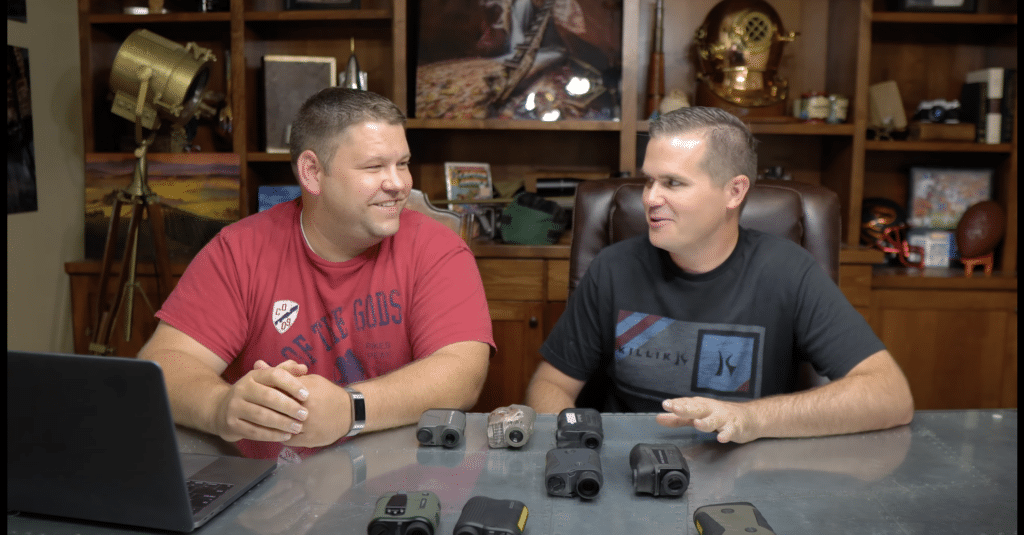
If you’ve done much shooting, you’ve probably been to the counter at the sporting goods store where they keep the rangefinders. And like us, you’ve probably been astounded at the selection. It seems like every name in optics has at least 4 options! How can you possibly pick the right one?
After using several brands of rangefinders, there weren’t any specific range finders that I would recommend based on a cool feature it had. But for a good price, great usability, and an easy-to-use device, we would have to go with the Leupold RX-2800 | TBR-W (link to Amazon).
There are known brands with options starting in the mid $100’s and capping out at over $1,000. Is it worth it to buy the expensive one? What do you get for the extra bucks?
We had a lot of questions so we went out and bought eight rangefinders that range in price from $140 to $800. We compared them on a bunch of criteria, like accuracy, range, speed, build, quality. What we found, surprised us.
We have a clear winner, and it wasn’t any of the ones most recommended by the salesmen. Here are links to most of the rangefinders we talk about in this video.
Don’t Want to Read This Whole Article? Here Are My Favorites.
- Best overall rangefinder in our test: Link to Amazon to check price
- Second best rangefinder in our test: Link to Amazon to check price
- Best rangefinder with Bluetooth connectivity: Link to Amazon to check price
The Best Rangefinder for General Use
Starting out we wanted to just go ahead and tell our picks for what we personally would take out in the field hunting this summer.
Both Ricky and I’s pick would have to be the Leopold Rx1600i TBRW. It wasn’t too expensive, it was an easy device to use, and it had fantastic capability when it came to distance reading.
To give you an all-inclusive review of these range finders we went down the list and chose which one would best suit different types of people who would potentially be in the market for one of these things. This included buyers who are super price-conscious, those who want a mid-range device, the hunter, and the long-range shooter.
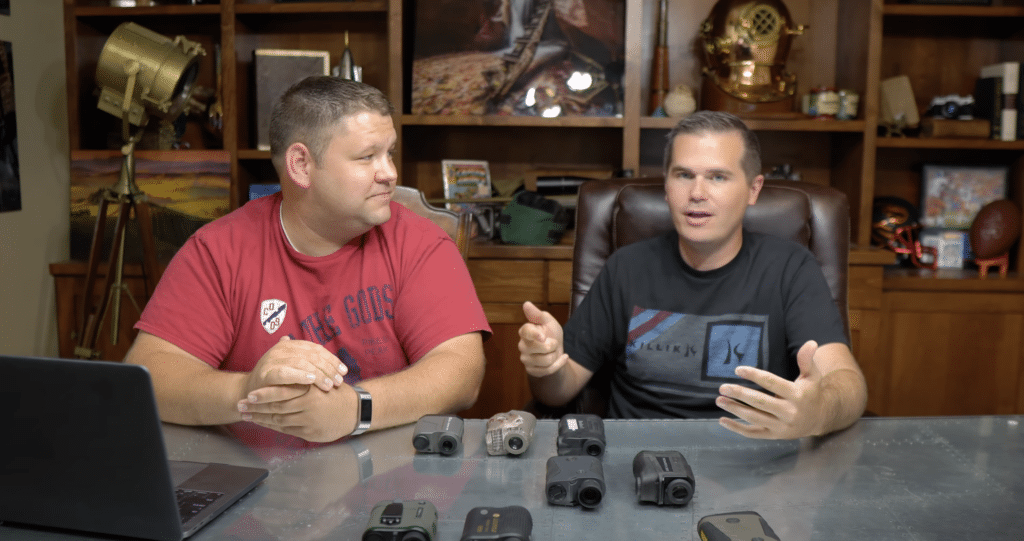
The Price Conscious
There are three that are at the very low-end range of the price category, priced at $200 and under. That list includes the Bushnell Prime 1300, the Pursuit XR700, and the Nikon Prostaff 1000. My personal pick, whether for hunting, shooting, or golf, was the Nikon Prostaff 1000.
Pursuit XR700
The Pursuit XR700 is the cheapest out of the option, but only by about $20. It was priced at $139.99 while the other two were priced at $169.99. This cheaper pricing makes sense seeing as it’s just not a good rangefinder. Even the salesman at the store stated that he never recommended the Pursuit XR700.
The battery door is awful, lasting only about five minutes before it breaks. The image quality is terrible. And it did also gave us inconsistent numbers. While it was generally accurate, some weird readings did pop up a few times.
Bushnell Prime 1300
The Bushnell had some similar issues. While long-range it did decent, at 50-60 yards it would consistently be off by around 10 yards. That’s a big difference when it comes to smaller numbers like that. While the rest of the rangefinders would be off by a quarter of a yard, the Bushnell had the most inaccurate readings.
It’s just not worth buying, especially when you realize that the Nikon ProStaff 1000 is the same price and gives much more accurate readings on a consistent basis.
Nikon ProStaff 1000
With this rangefinder there just weren’t any of the weird issues we had with the other two that were in this price point. It does it’s thing, but we do have to say that it was just unremarkable.
The longest reading we were able to get in good lighting conditions, with some good cloud cover, was 875 yards. It’s maximum reading in sagebrush was also 875 yards. And it’s maximum reading in low lighting, which is still decent, was 640 yards.
So for the three rangefinders just mentioned, you can easily use them for bowhunting, no problem. If you’re just going hunting and not shooting more than 600-700 yards, these are great. Another thing to mention is that with these rangefinders, you’re not losing an accuracy.
If you compare the Nikon ProStaff 1000 to the more expensive options, you’re only going to be about 1-2 yards off in accuracy (even at 400 yards.) So if you want something cheap, that is going to do the job and you aren’t planning on shooting more than around 600 yards, it’s a solid choice. While the build quality is plastic and unremarkable, you’re going to do perfectly fine with the Nikon.
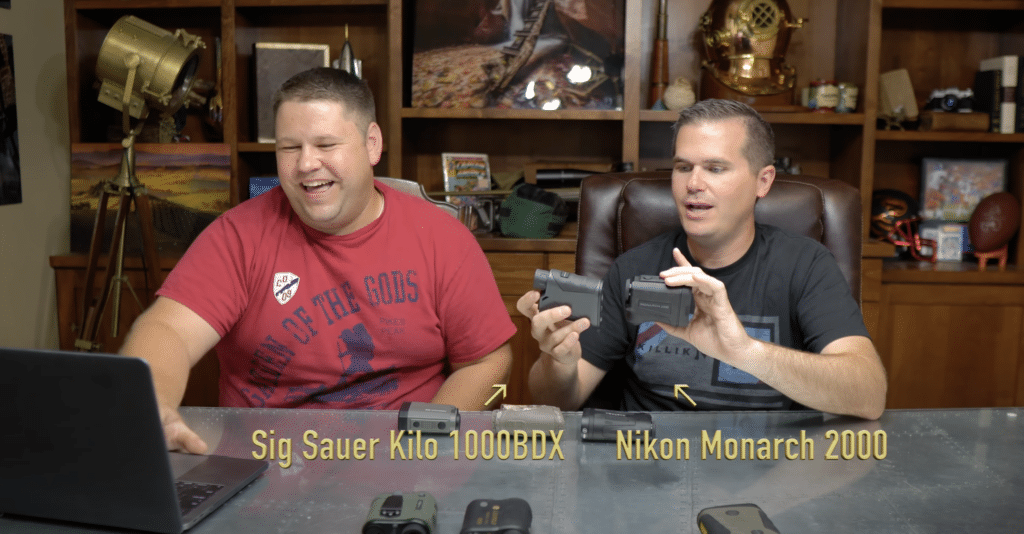
Mid-Range Options
If you’re still price-conscious, but want more bang for your buck, there are a few mid-range options that we tested out for you. Those include the Nikon Monarch 2000, and the Big Sauer Kilo 1000BDX. We actually ended up greatly debating which one of these two options is better.
Nikon Monarch 2000
Something to mention about the Nikon Monarch 2000 is that it is waterproof, which is huge when it comes to outdoor activity. It also just feels tough, like we could scratch it and beat it up and it would still last us a really long time.
Despite it’s great build quality, it did end up being a little difficult to use. You may have to attempt to use it a few time before the numbers will come back to you. It also seemed to take the longest to get a reading, compared to the other rangefinders in the higher end.
Something else we did notice about the Monarch is that the glass isn’t very forgiving. If you’re just off by a little bit you see these little black things everywhere that none of the other rangefinders showed. The cheaper rangefinders, if you get off the axis get a little bit hazy, which can really be annoying. We noticed that the Monarch is a darker haze than the other rangefinders, which is distracting.
That being said, the range did, surprisingly, outperform the Big Sauer by about 500 yards, which is significant. With good lighting we got 1570 yards, which was the same reading in sagebrush. In dim lighting, we got an even better reading at 1621 yards.
So overall, it’s a really good rangefinder, it just has a few small issues that we thought we would disclose.
Big Sauer Kilo 1000BDX
Compared to the Nikon Monarch, the Big Sauer did end up feeling like a nice car. You can’t really beat up on it like you could the Monarch. When you hold it you feel like you need to be gentle with it. It has that fine plastic protector that doesn’t really do much to protect it.
The longest reading we could get out the Big Sauer Kilo was 1100 yards. In the sagebrush, the longest reading we could get was also 1100 yards. And in low lighting, the longest reading we received was 1025 yards.
When it came down to choosing between the Nikon Monarch and the Big Sauer Kilo, it was just too close of a tie and I couldn’t do it. It just depends on you and whether you care about your rangefinder being waterproof, how far it needs to read, and how many small issues you’re willing to put up with.
Higher End Options
Our next options are the most expensive of the group at around $350. If you’re looking to really spend some time with your range finder, and you need to be able to read very long distances with a reliable device, these are the options for you.
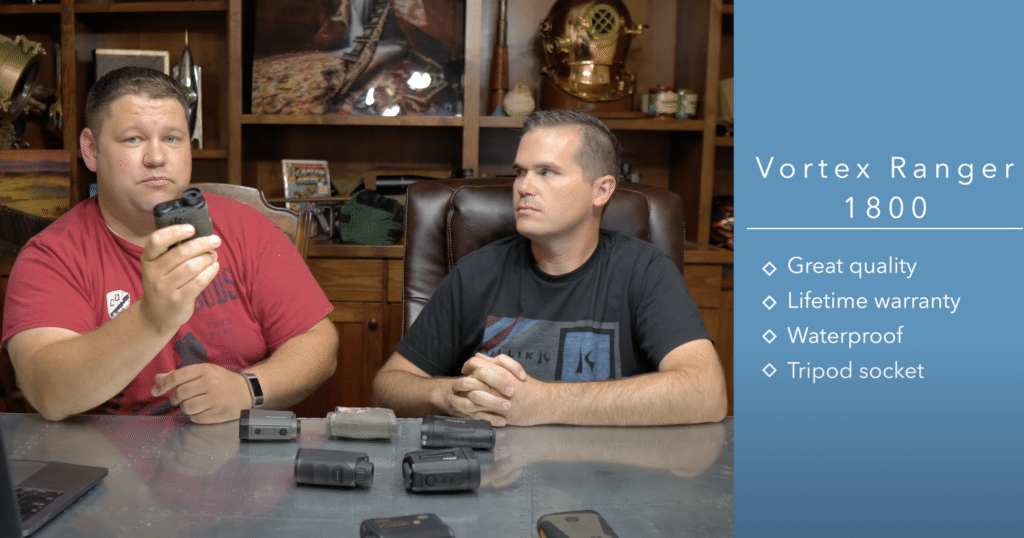
Vortex Ranger 1800
The Vortex Ranger 1800 is the rangefinder that everyone seems to be talking about, and also what the sporting goods store told us the model that flying off the shelves. That’s because it’s just such great quality. And it also has a lifetime warranty, which incredibly nice. Unless it’s lost or stolen, you can just send it back and they will give you a new one.
It’s also waterproof, which is extremely handy. And it also is the only rangefinder of our collection that has a tripod socket on the bottom. While I did at first wonder why every rangefinder didn’t have a tripod socket, it also occurred to me that I don’t really use a tripod, so I’m not sure it’s worth it to me to buy this model.
The rangefinder is pretty easy to hold just with your hand. And even if it gets shaky at around 1000 yards, if you have something to lean against, it’s not hard to see what you need to see and get a reading. So I guess if you prefer to use a tripod, this rangefinder is probably the one for you.
Overall, while we expected that this rangefinder was going to be top-notch we ended up being disappointed. While it is a solid rangefinder, it was a disappointing one, based on how much we expect of it out of the box
The Leopold, side by side with the Vortex Ranger, ended up being able to range quite a bit farther. While manufacteres will tell you that the number mentioned after the logo is how many yards it’s able to read.
The Vortex Ranger, side by side with the Leopold, ended up being able to range quite a bit farther. Manufacturers state that the number mentioned after the logo is how many yards it’s able to read on a reflective surface. On a non-reflective surface, you can cut that number in half and that’s what you’re going to be able to read with that rangefinder.
With this rangefinder, a maximum of 950 yards was the best we’re able to get. In sagebrush, 800 yards was about what we could get. With low lighting, we only could read a maximum of 649 yards. Personally, if I’m hunting, that is plenty of space for my rangefinder to be able to read. But if you want to do the long-range shooting, it’s just not going to cut it.
Leupold RX-2800 | TBR-W
The Leupold RX-2800 | TBR-W was extremely reliable with its long-range and very fast. It also has a two-year warranty, which is very nice for people who seem to have bad luck with devices like this.
That’s 600 yards more than the Vortex Ranger, so if you’re doing any sort of long-range shooting this is the model for you. It also just gave us extremely fast readings. While the Vortex was pokey, and I had to try several times to get it to read what I wanted it to, the Leupold would give me very quick readings.
The maxiumum reading we could get with the Leupold was 1570 yards. In sagebrush and low-lighting it could also read around 1570 yards, which is almost a mile in distance!
Overall, when you combine just how nice of a device it is, the amenities it features, and how much better it is than the other range finders, we decided this device would be the one we would take out in the field.
Best For Hunting
While the other rangefinders were great, a big question we had when we were researching and testing out these devices was which one of them would be perfect specifically for hunting.
While personally, I would have absolutely no problem with taking the Vortex out hunting, seeing as it’s reliable and I don’t need it to read that large of distances, there was a debate going on. While the belt clip it featured was neat, it ended up being too pokey to be my first pick.
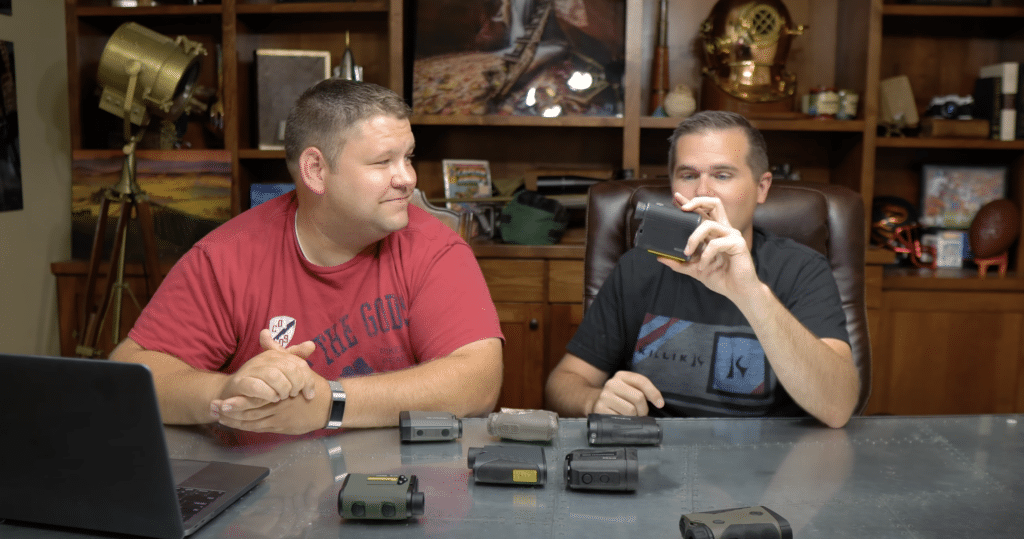
The Leupold, instead, just gives you a lot of capability when it comes to readings. While you may not need to be able to read 1500 yards, it’s nice to be able to on those rare occasions you need to.
Instead, we agreed that the Leupold was your best bet when it came to which range finder was the best when it came to hunting.
Best Long Range Shooting
Sig Sauer Kilo 2400BDX
When it came to the maximum amount of range, the Sig Sauer Kilo 2400BDX was unparalleled. It is double the price of the mid-range range finders, so do keep that in mind if you are on a budget.
There are some very nice things about this range finder, which you would expect from a device that costs so much. It has a very nice build and its max readings for us were up to 2120 yards on a hard surface. While it was a little pokey for us at that distance, it still had really nice readings at that far of a distance.
Some things to note is that it is substantially larger in size than the other range finders, it does have a plastic frame, which is less than ideal, and there are also no other features for the extravagant price.
While we did get more consistent readings from the Leupold than the Sig, the Sig is just not to be beaten when it comes to ability. For all of your long-range needs, this model is going to be your best bet for when you need to read the farthest of ranges.
When it comes to price, the Leupold is only half the price, though, which is a lot of money for your average hunter. The Sig also doesn’t give you too much more capability when it comes to reading distances. So if you know you’re going to need a device that can read that much, and money isn’t an issue with you, by all means, go buy the Sig Sauer Kilo 2400 BDX.
Final Conclusions
While we did think we were going to be getting more features on these rangefinders for the amount of money they cost, we ended up realizing that most of them are just simply just distance finders. That’s about it. You pick it up and you look through it. The only other thing you’re going to want it to do is to compensate for an angle, which they will do.
Another spec we noticed was the magnification featured with the Sig 2400 was 7X25MM, while most of the other ones were around 6X22MM (though not the Sig 1000, which had 5X20MM.)
So overall, there weren’t any specific range finders that I would recommend based on a cool feature it had. But for a good price, great usability, and an easy to use device, we would have to go with the The Leupold RX-2800 | TBR-W.
Check out our YouTube video below to see more examples of the rangefinders we tested in action.









